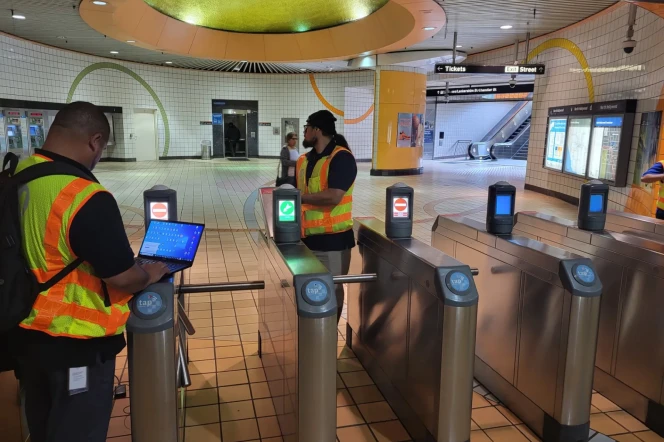With our free press under threat and federal funding for public media gone, your support matters more than ever. Help keep the LAist newsroom strong, become a monthly member or increase your support today.
25 Years After The Northridge Earthquake, Is LA Ready For The Big One?

Twenty five years ago, at 4:30 a.m. on Jan. 17, 1994, the Northridge earthquake shook Angelenos from their beds. For those of us who lived through it, the memories of chaos early in the morning are unforgettable.
"We were just literally startled awake by a freight train driving right through our bedroom," said my father, Mark Margolis, who along with my sister, my mother and myself, was sleeping just about seven miles from the epicenter. "I mean the blinds that were supposed to be hanging vertical were like out horizontal. So, there was a tremendous amount of movement."
I was only five, and remember being pulled from my bed into the dark hallway by my parents. Our house was trashed, with everything from our shelves and inside our refrigerator thrown to the ground.
I mean the blinds that were supposed to be hanging vertical were like out horizontal. So, there was a tremendous amount of movement.
After things calmed down, we walked outside. I remember dark silhouettes of my neighbors milling about, trying to figure out what to do, just as dawn began to break and aftershocks rolled through.
When the sun rose, everyone was able to take stock of the damage.
The 6.7 magnitude earthquake destroyed freeways and buildings, cracked streets and left swaths of Los Angeles without power for a period of time.
"I remember driving down one of the main streets and there was like water coming up from the ... street because there were broken gas lines as well as broken water lines. There was water, but there were also flames coming out of the water," my dad said. "So, burning water ... I mean how often do you see that?"
At least 57 people died and $40 billion in damage was done.
Many Angelenos were displaced for a period of time. Some people were lucky enough to stay with family and friends. Some had to live for days in parks as the structural integrity of their buildings was assessed.
Prepared for the next one?
Every time an earthquake hits, we learn new things about just how unprepared we are.
Since Northridge, building codes have improved and retrofit programs for hospitals, apartments and freeways have been implemented. The hope is that those improvements leave us safer. But Southern California hasn't had an earthquake strong enough to test the region in earnest anytime since.
About 7,000 miles of water pipes are currently being retrofitted by the Los Angeles Department of Water and Power, so that they don't crack in an earthquake. That could mean contamination or complete loss of water to homes. Craig Davis, the Water System Resilience Program Manager, said that it will take 120 years to fix the entire system.
According to seismologists, an earthquake far bigger than Northridge could hit at anytime.
Dr. Lucile Jones was the lead author on a 2008 report called " The ShakeOut Scenario " for the U.S. Geological Survey. In it, they describe a theoretical but likely earthquake: A 7.8 magnitude temblor on the southern San Andreas fault that would be 44 times stronger than Northridge.
The report estimates that if that earthquake occurs, 1,800 people could die, buildings could collapse, an estimated $200 billion in damage could be done and conflagrations could break out.
We're better prepared for the big one than any big city in America, which is to say, we're woefully unprepared.
"Northridge was an event that disrupted the lives of people in the San Fernando Valley extensively ... disrupted our community for a year or two," Dr. Jones said. "The big San Andreas earthquake is going to disrupt the lives of everybody in Southern California and it could take us decades to recover what we lose."
LA Mayor Eric Garcetti has worked with Jones to implement various programs designed to improve the city's resilience . "We're better prepared for the big one than any big city in America," he says, "which is to say, we're woefully unprepared."
Limited water and overwhelmed emergency services after a big quake hits could mean large fires spreading quickly throughout the hills and neighborhoods, according to Jones. Mark Ghilarducci, director of California Governor's Office of Emergency Services, said it could take 48 to 72 hours for outside help to arrive in Southern California. Meaning, 10 million people should expect to be largely on their own for a few days after the disaster.
There is some good news: "Most of the time under most circumstances ... you're going to see people become the best version, the most altruistic version of themselves, especially in those first couple of minutes and moments after the event," said Joe Trainor, who studies disasters and crisis at the University of Delaware.
That said, to survive a major earthquake, it's important that people take steps to prepare . Stock up on water, food, medicine and make sure that there's some alternate form of shelter in case homes are unlivable. Everyone who lives in an earthquake zone should have some sort of emergency plan in place and coordinate that plan with friends and family.
This story comes from the producers and host of a new podcast, " The Big One - Your Survival Guide. "
Copyright 2024 LAist 89.3. To see more, visit
LAist 89.3
. 9(MDA1OTI3MjQ5MDEyODUwMTE2MzM1YzNmZA004))








